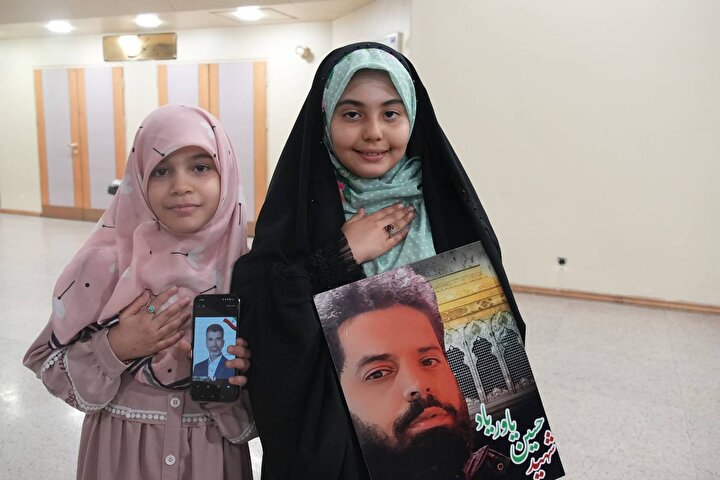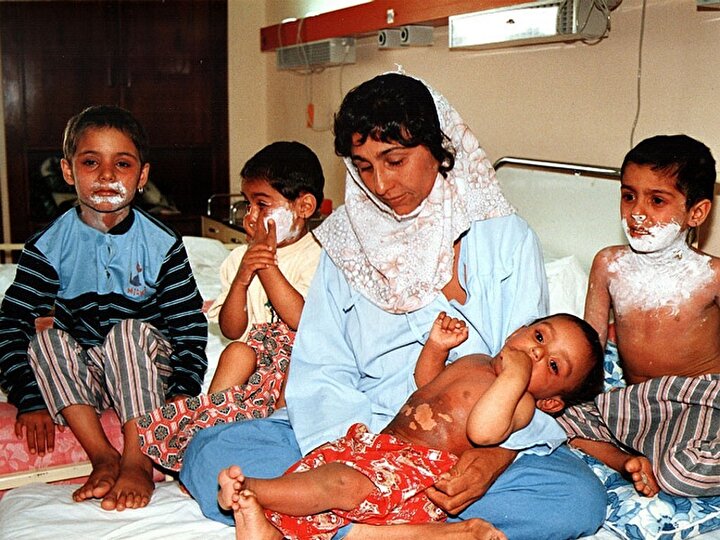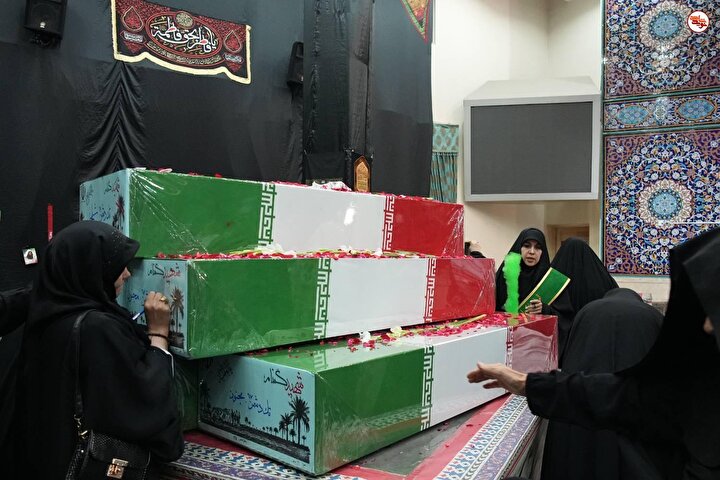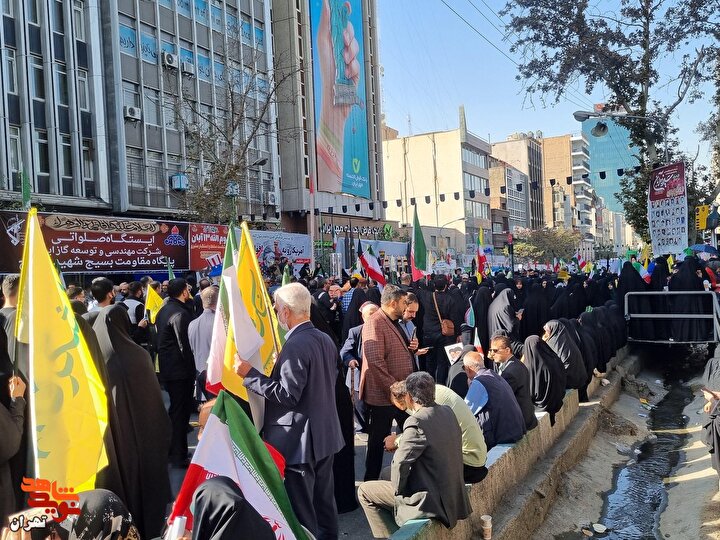For the Anniversary of Iranian POWs Homecoming:
A Review of the Shahed Yaran Latest Issue Titled \"Naghme Radmardi\" (Meaning the Song of Chivalry)
A Review of Shahed Yaran Latest Issue Titled \"Naghme Radmardi\" (Meaning the Song of Chivalry)

According to Navideshahed, the 9th volume of the cultural and historical magazine of Shahed Yaran is for the anniversary of prisoners of war return to the Islamic homeland which is titled as ‘Magnanimity song’. The magazine was released by Shahed in August 1986.
In this volume there are some contents with titles of preamble, the situation of prisoners of war in the mirror of the revolution’s architecture, the charter of captivity in the mirror of the supreme leader statements, a selection of the letters relevant to the captivity era of prisoners of war, poem, the prisoners of war in the mirror of released and published works.
In a section of the memories of the prisoner of war ‘Hassan Mohammadi’ it has been mentioned: The first mental torture that they did was that they made all the prisoners of war naked in front of others and they investigated their bodies. For example it could be considered a very big mental blow for Mr. Modaraei who was 51 years old. After the investigation, they asked us to wear our uniforms. After that they sent all of us to the cells. The cells included the rooms with area of 3 X 6 meters. When we entered the rooms, the wall and the ground of the rooms were full of faeces and blood. When the prisoners of war had been beaten and their hands and faces had hit the wall, such a situation had been created and since they had not given any dishes to the prisoners of war in order to put their faeces inside that, so the whole environment of the cells had been full of faeces. We could hear the voice of tortures continuously from the side cells.
In this magazine some interviews have been conducted with Hojjat Ol Islam Val-Moslemin Mohammad Hassan Rahimiyan, the representative of the supreme leader in the Foundation of Martyrs and Veterans Affairs regarding the prisoners of war and Imam, a comparison between the Iranian prisoners of war and the Iraqi prisoners of war and remembering the Sayyed of prisoners of war, the prisoner of war ‘Bizhan Kiyani’ with the subject of ‘Some manifestations of the behavior of the Sayyed of prisoners of war, Engineer Mohsen Yahyavi with the subject ‘The fortitude narration of Tondgoyan’, the prisoner of war ‘Ali Akbar Erfhani’, Dr. Seyed Amir Razaviyan Ardehanli, the prisoner of war ‘Mohammad Zakeri’ and the prisoner of war ‘Abdol Majid Rahmaniyan’ with the subject of ‘Some manifestations of passion trip’, the prisoner of war ‘Mohammad Jokar’ with the subject ‘The prohibition related to the captivity era’, ‘the prisoner of war ‘Mohammad Reza Mir Shamsi’ with the subject ‘The prisoners of war and the propaganda of the Ba’ath party of Iraq, the prisoner of war ‘Fariborz Khob Nezhad’ with the subject ‘The religious and captivity era mottos’, with the prisoner of war ‘Fatemeh Nahidi’, the prisoner of war ‘Masoumeh Abad’, the prisoner of war ‘Khadijeh Mirshekar’ with the subject of women and captivity, the prisoner of war ‘Mehdi Tahaniyan with the subject ‘captivity and adolescence’, the prisoner of war ‘Rostam Khorramdin’ with the subject ‘the religious minorities and captivity’, the prisoner of war ‘Seyed Assadollah Mir Mohammadi’ with the subject ‘a half outlook towards the role of the spouses of the prisoners of war’, the prisoner of war ‘Major Nasrallah Oromchi’ with the subject ‘the challenges of commandership in Romadi camp’, ‘the prisoner of war ‘Saeed Ohadi’ with the subject ‘from California university to captivity university’, the prisoner of war ‘Hassan Mohammadi’ with the subject of ‘The vanguard of a decade of captivity’, the prisoner of war ‘Tayefeh Nourouz’ with the subject ‘the challenges of controlling the camp’, the prisoner of war Ali Reza Shams with the subject ‘the sayings of sufferings’, Habibollah Masoum titled ‘establishing a news agency in captivity’, the prisoner of war ‘Eisa Daneshvar’ with the subject ‘captivity, struggles and amusements’, the prisoner of war colonel Shahab Al-Din Shahbazi with the subject ‘Prisoners of war and the propaganda of the MKO forces’, the prisoner of war ‘Seyed Mohammad Reza Abtahi’ with the subject ‘Captivity and the concern of memorizing the handwriting texts’.
In a section of the memories of the late Abutorabi based on the narration of Mohammad Hassan Rahimiyan has been mentioned: “The respectful Sayyed, I’m a pure man of God, Mr. Abutorabi, the magnificent symbol for the prisoners of war. Before he reaches the peak of greatness in the human making university of captivity, he accomplished the steps of greatness in Najaf Ashraf near the grave of the chief of the faithful Ali (AS). He learnt lessons in the school of Imam Khomeini. During those years, I had a close relationship with him. The intellectual behaviors, politeness, greatness, dignity and honor, piety and sincerity and honesty could be seen in all the dimensions of his life and all the features of him would remind us of the good men of God. All of these purity could be more explicit during the walking that he did towards Mecca. He did this action several times. He would walk from Najaf to Karbala several times a year. I can remember that he would mostly attend the Caravan of martyr Ayatollah Madani. I and martyr Haj Agha Mustafa would mostly attend the caravan of Mr. Habibi. Each caravan consisted of 40 members only. These caravans would usually move in a parallel condition and when they wanted to stop, they would reach the same place. Anyways, the intellectual and spiritual behavior of the cleric Abutorabi in the way of visiting the shrine of Imam Hussein (AS) was a very memorable and interesting scene. After freedom, he would continue his walking along with other prisoners of war. He walked to the holy Mashhad city several times. Also he climbed Damavand top several times too. He went to the Khorsravi borders in many cases. Anyways, he would pass the very long distances so easily, because he had got used to this condition from the time that he was a young man. Eventually he passed away when he had accompanied his old father in order to take part in the memory night occasion of one of the martyrs and for the purpose of visiting the shrine of Imam Reza (AS). Humility, generosity were the main features of this respectful Sayyed as well.
At the continuation of the texts of this volume of Shahed Yaran Magazine, there are some textures titled ‘The role of prisoners of war in creating and stabilizing the Islamic system in the speeches mirror of martyr Ayatollah Mohallati, the respectful representative of Imam Khomeini in the Islamic Revolutionary Guards Corps of Islamic Revolution, a review on the biography of the Sayyed of prisoners of war, the late Hojjat Ol Islam Sayyed Ali Akbar abutorabi, ‘from the eyes of brother…Hojjat Ol Islam Val-Moslemin Seyed Mohammad Hassan Abutorabi’, ‘How I was captured? A page from the memories of the Sayyed of prisoners of war’, ‘A lyric poem of the Sayyed of Prisoners of War penned by martyr Dr. Mustafa Chamran’, ‘the attitude of the Sayyed of prisoners of war in the mirror of memories of engineer Seyed Mortaza Nabavi and in the mirror of the memories of Hojjat Ol Islam Val-Moslemin Majid Ansari, the behavior of the Sayyed of prisoners of war in the mirror of his comrades.”?
In the section of status of prisoners of war in the mirror of revolution’s architecture outlook, some statements of Imam Khomeini regarding the anniversary of prisoners of war return to homeland have been mentioned. Some sentences such as: The prisoners of war in the claw of executioners are the same as the song of freedom and the world whispers the names of them. The missing war veterans are the same as an everlasting sea and the natural poor people and the rich people regret for their positions (1983), while this words are a lie and our narration accepts these prisoners of war in a humanitarian and Islamic mode in a way that they behave so well. Anyone from the world who wants to see this scene, they can come here and do that (1981). We did something with the prisoners of war that no one would do with their prisoners. We behaved with the Iraqi prisoners of war the same as our own brothers, while they tortured our prisoners of war so much. Even our Oil Minister is being tortured by them now. (1981). There is a difference between their behaviors of those who behave the prisoners of war the same as their own brothers and those who torture and persecute their prisoners of war while they have been mostly the Arabs from the villages and cities who have not intervened in the war as well (1983). I would like to express my greeting to the disables and missing war veterans and the prisoners of war. In fact they are the prides of their Islamic country and God bless those great women who raised such strong men (1984). What can be given instead of the action of the respectful mothers who raised and educated such great children to them? What can we do for the prisoners of war who tolerated much difficulties in the fearful and frightening and dark prisons? (1984), God! Return the prisoners of war who were the great men of our country and make us and this nation happy by their return to our country (1987). I hope that God will free those prisoners of war who have been jailed in the Iraqi camps, those disables who have been kept there. Also I hope that God will make all of us familiar with our duties (1988).
In this volume of the Shahed Yaran Magazine there are some pure and excellent photos related to the camps, the freedom moment and the entry to the homeland….which have been published.
The 9th volume of Shahed Yaran Magazine is a memorial for the prisoners of war return to the Islamic homeland. The magazine has been compiled in 93 pages by the collaboration of the Research and Information Center of the Foundation of Martyrs and Veterans Affairs by the chief secretary of Abbas Khameh Yar.
The End
According to Navideshahed, the 9th volume of the cultural and historical magazine of Shahed Yaran is for the anniversary of prisoners of war return to the Islamic homeland which is titled as ‘Magnanimity song’. The magazine was released by Shahed in August 1986. In this volume there are some contents with titles of preamble, the situation of prisoners of war in the mirror of the revolution’s architecture, the charter of captivity in the mirror of the supreme leader statements, a selection of the letters relevant to the captivity era of prisoners of war, poem, the prisoners of war in the mirror of released and published works. In a section of the memories of the prisoner of war ‘Hassan Mohammadi’ it has been mentioned: The first mental torture that they did was that they made all the prisoners of war naked in front of others and they investigated their bodies. For example it could be considered a very big mental blow for Mr. Modaraei who was 51 years old. After the investigation, they asked us to wear our uniforms. After that they sent all of us to the cells. The cells included the rooms with area of 3 X 6 meters. When we entered the rooms, the wall and the ground of the rooms were full of faeces and blood. When the prisoners of war had been beaten and their hands and faces had hit the wall, such a situation had been created and since they had not given any dishes to the prisoners of war in order to put their faeces inside that, so the whole environment of the cells had been full of faeces. We could hear the voice of tortures continuously from the side cells. In this magazine some interviews have been conducted with Hojjat Ol Islam Val-Moslemin Mohammad Hassan Rahimiyan, the representative of the supreme leader in the Foundation of Martyrs and Veterans Affairs regarding the prisoners of war and Imam, a comparison between the Iranian prisoners of war and the Iraqi prisoners of war and remembering the Sayyed of prisoners of war, the prisoner of war ‘Bizhan Kiyani’ with the subject of ‘Some manifestations of the behavior of the Sayyed of prisoners of war, Engineer Mohsen Yahyavi with the subject ‘The fortitude narration of Tondgoyan’, the prisoner of war ‘Ali Akbar Erfhani’, Dr. Seyed Amir Razaviyan Ardehanli, the prisoner of war ‘Mohammad Zakeri’ and the prisoner of war ‘Abdol Majid Rahmaniyan’ with the subject of ‘Some manifestations of passion trip’, the prisoner of war ‘Mohammad Jokar’ with the subject ‘The prohibition related to the captivity era’, ‘the prisoner of war ‘Mohammad Reza Mir Shamsi’ with the subject ‘The prisoners of war and the propaganda of the Ba’ath party of Iraq, the prisoner of war ‘Fariborz Khob Nezhad’ with the subject ‘The religious and captivity era mottos’, with the prisoner of war ‘Fatemeh Nahidi’, the prisoner of war ‘Masoumeh Abad’, the prisoner of war ‘Khadijeh Mirshekar’ with the subject of women and captivity, the prisoner of war ‘Mehdi Tahaniyan with the subject ‘captivity and adolescence’, the prisoner of war ‘Rostam Khorramdin’ with the subject ‘the religious minorities and captivity’, the prisoner of war ‘Seyed Assadollah Mir Mohammadi’ with the subject ‘a half outlook towards the role of the spouses of the prisoners of war’, the prisoner of war ‘Major Nasrallah Oromchi’ with the subject ‘the challenges of commandership in Romadi camp’, ‘the prisoner of war ‘Saeed Ohadi’ with the subject ‘from California university to captivity university’, the prisoner of war ‘Hassan Mohammadi’ with the subject of ‘The vanguard of a decade of captivity’, the prisoner of war ‘Tayefeh Nourouz’ with the subject ‘the challenges of controlling the camp’, the prisoner of war Ali Reza Shams with the subject ‘the sayings of sufferings’, Habibollah Masoum titled ‘establishing a news agency in captivity’, the prisoner of war ‘Eisa Daneshvar’ with the subject ‘captivity, struggles and amusements’, the prisoner of war colonel Shahab Al-Din Shahbazi with the subject ‘Prisoners of war and the propaganda of the MKO forces’, the prisoner of war ‘Seyed Mohammad Reza Abtahi’ with the subject ‘Captivity and the concern of memorizing the handwriting texts’. In a section of the memories of the late Abutorabi based on the narration of Mohammad Hassan Rahimiyan has been mentioned: “The respectful Sayyed, I’m a pure man of God, Mr. Abutorabi, the magnificent symbol for the prisoners of war. Before he reaches the peak of greatness in the human making university of captivity, he accomplished the steps of greatness in Najaf Ashraf near the grave of the chief of the faithful Ali (AS). He learnt lessons in the school of Imam Khomeini. During those years, I had a close relationship with him. The intellectual behaviors, politeness, greatness, dignity and honor, piety and sincerity and honesty could be seen in all the dimensions of his life and all the features of him would remind us of the good men of God. All of these purity could be more explicit during the walking that he did towards Mecca. He did this action several times. He would walk from Najaf to Karbala several times a year. I can remember that he would mostly attend the Caravan of martyr Ayatollah Madani. I and martyr Haj Agha Mustafa would mostly attend the caravan of Mr. Habibi. Each caravan consisted of 40 members only. These caravans would usually move in a parallel condition and when they wanted to stop, they would reach the same place. Anyways, the intellectual and spiritual behavior of the cleric Abutorabi in the way of visiting the shrine of Imam Hussein (AS) was a very memorable and interesting scene. After freedom, he would continue his walking along with other prisoners of war. He walked to the holy Mashhad city several times. Also he climbed Damavand top several times too. He went to the Khorsravi borders in many cases. Anyways, he would pass the very long distances so easily, because he had got used to this condition from the time that he was a young man. Eventually he passed away when he had accompanied his old father in order to take part in the memory night occasion of one of the martyrs and for the purpose of visiting the shrine of Imam Reza (AS). Humility, generosity were the main features of this respectful Sayyed as well. At the continuation of the texts of this volume of Shahed Yaran Magazine, there are some textures titled ‘The role of prisoners of war in creating and stabilizing the Islamic system in the speeches mirror of martyr Ayatollah Mohallati, the respectful representative of Imam Khomeini in the Islamic Revolutionary Guards Corps of Islamic Revolution, a review on the biography of the Sayyed of prisoners of war, the late Hojjat Ol Islam Sayyed Ali Akbar abutorabi, ‘from the eyes of brother…Hojjat Ol Islam Val-Moslemin Seyed Mohammad Hassan Abutorabi’, ‘How I was captured? A page from the memories of the Sayyed of prisoners of war’, ‘A lyric poem of the Sayyed of Prisoners of War penned by martyr Dr. Mustafa Chamran’, ‘the attitude of the Sayyed of prisoners of war in the mirror of memories of engineer Seyed Mortaza Nabavi and in the mirror of the memories of Hojjat Ol Islam Val-Moslemin Majid Ansari, the behavior of the Sayyed of prisoners of war in the mirror of his comrades.”? In the section of status of prisoners of war in the mirror of revolution’s architecture outlook, some statements of Imam Khomeini regarding the anniversary of prisoners of war return to homeland have been mentioned. Some sentences such as: The prisoners of war in the claw of executioners are the same as the song of freedom and the world whispers the names of them. The missing war veterans are the same as an everlasting sea and the natural poor people and the rich people regret for their positions (1983), while this words are a lie and our narration accepts these prisoners of war in a humanitarian and Islamic mode in a way that they behave so well. Anyone from the world who wants to see this scene, they can come here and do that (1981). We did something with the prisoners of war that no one would do with their prisoners. We behaved with the Iraqi prisoners of war the same as our own brothers, while they tortured our prisoners of war so much. Even our Oil Minister is being tortured by them now. (1981). There is a difference between their behaviors of those who behave the prisoners of war the same as their own brothers and those who torture and persecute their prisoners of war while they have been mostly the Arabs from the villages and cities who have not intervened in the war as well (1983). I would like to express my greeting to the disables and missing war veterans and the prisoners of war. In fact they are the prides of their Islamic country and God bless those great women who raised such strong men (1984). What can be given instead of the action of the respectful mothers who raised and educated such great children to them? What can we do for the prisoners of war who tolerated much difficulties in the fearful and frightening and dark prisons? (1984), God! Return the prisoners of war who were the great men of our country and make us and this nation happy by their return to our country (1987). I hope that God will free those prisoners of war who have been jailed in the Iraqi camps, those disables who have been kept there. Also I hope that God will make all of us familiar with our duties (1988). In this volume of the Shahed Yaran Magazine there are some pure and excellent photos related to the camps, the freedom moment and the entry to the homeland….which have been published. The 9th volume of Shahed Yaran Magazine is a memorial for the prisoners of war return to the Islamic homeland. The magazine has been compiled in 93 pages by the collaboration of the Research and Information Center of the Foundation of Martyrs and Veterans Affairs by the chief secretary of Abbas Khameh Yar. The End




